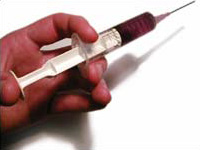
|  |  |  Health & Beauty | September 2009 Health & Beauty | September 2009  
New Rabies Vaccine May Require Only a Single Shot... Not 6
 Emily Shafer - Thomas Jefferson University Emily Shafer - Thomas Jefferson University
go to original
September 19, 2009


| | The current standard post-exposure regimen is not feasible in the developing world, where rabies is endemic. |  |
Philadelphia - A person, usually a child, dies of rabies every 20 minutes. However, only one inoculation may be all it takes for rabies vaccination, according to new research published in the Journal of Infectious Diseases by researchers at the Jefferson Vaccine Center.

A replication-deficient rabies virus vaccine that lacks a key gene called the matrix (M) gene induced a rapid and efficient anti-rabies immune response in mice and non-human primates, according to James McGettigan, Ph.D., assistant professor of Microbiology and Immunology at Jefferson Medical College of Thomas Jefferson University.

"The M gene is one of the central genes of the rabies virus, and its absence inhibits the virus from completing its life cycle," Dr. McGettigan said. "The virus in the vaccine infects cells and induces an immune response, but the virus is deficient in spreading."

The immune response induced with this process is so substantial that only one inoculation may be sufficient enough, according to Dr. McGettigan. In addition, the vaccine appears to be efficient in both pre-exposure and post-exposure settings.

Currently, the World Health Organization standard for rabies infection is post-exposure prophylaxis. The complex regimen in the United States requires six different shots over 28 days: five of the rabies vaccine and one of rabies immunoglobulin.

The current standard vaccine is made from inactivated rabies virus, whereas the experimental vaccine is made from a live rabies virus. The virus is modified by removing the M gene, thus inhibiting its spread within the vaccine recipient.

Worldwide, the annual number of rabies-related deaths is estimated to be 40,000 to 70,000. The disease is endemic in developing areas, where the six-shot post-exposure regimen is not feasible for many people due to cost and availability. According to the World Health Organization, approximately 10 million people worldwide receive the post-exposure regimen, which presents a financial burden to both industrialized and developing countries.

"Developing countries do not have the resources to vaccinate people six times after exposure, so many of these 10 million do not receive the full regimen," Dr. McGettigan said. "Therefore, simpler and less expensive vaccine regimens are needed. The alternative may also be to treat people pre-exposure, as they are with many of the current vaccines used. Although our vaccine was tested primarily to be a post-exposure vaccine, the data we collected show it would be effective as a pre-exposure vaccine as well."

Dr. McGettigan recently was awarded a four-year $1.5 million R01 grant from the National Institutes of Health to continue his research on novel rabies vaccine approaches.

emily.shafer(at)jefferson.edu |

 |
|  |



